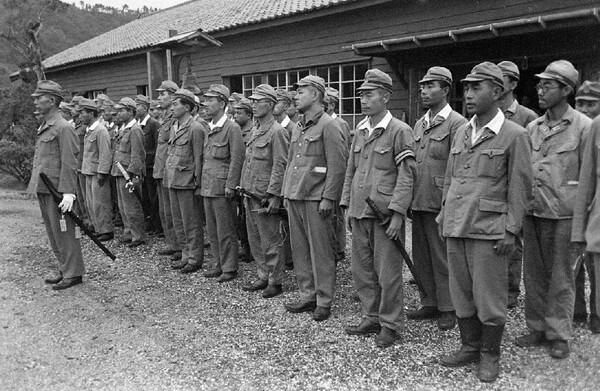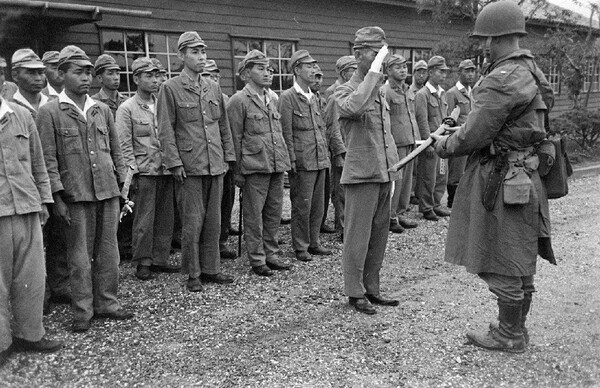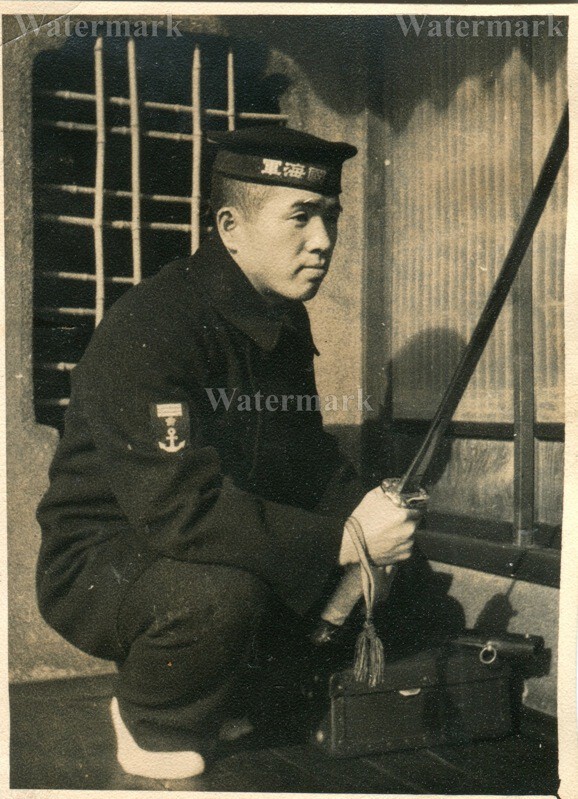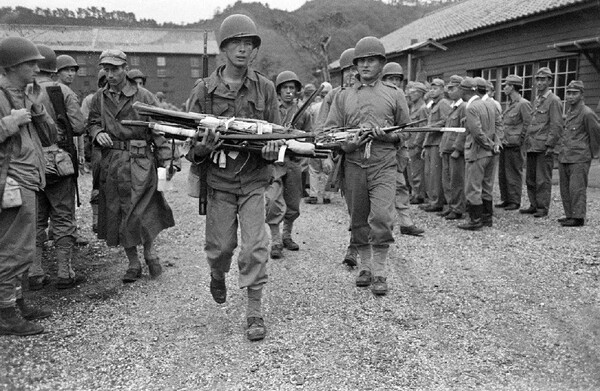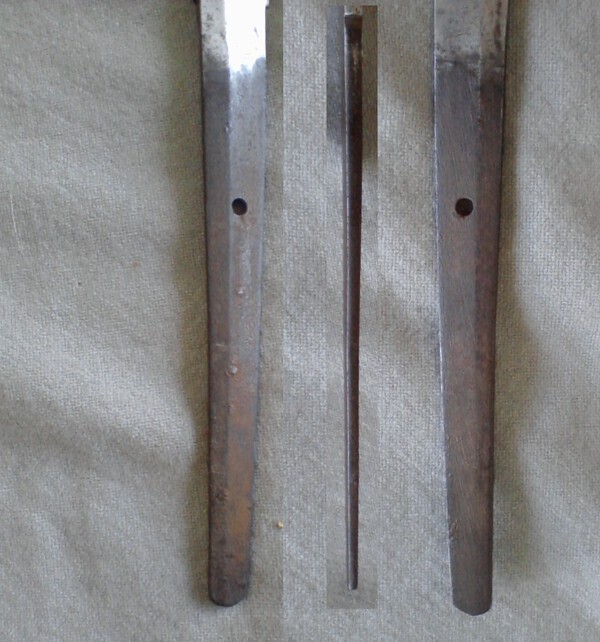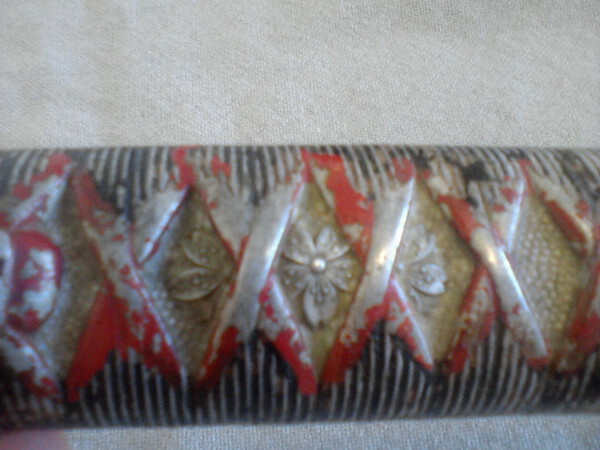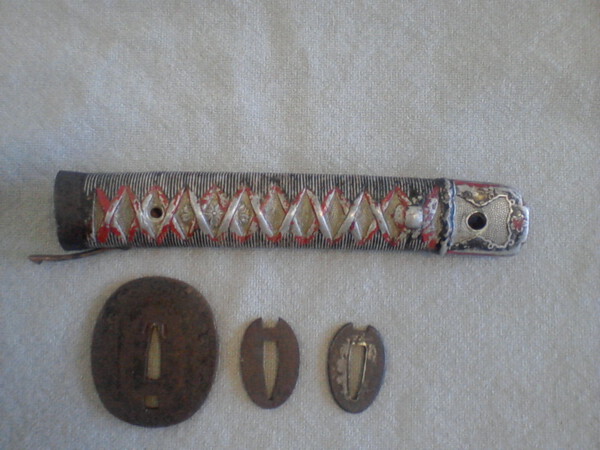-
Posts
1,690 -
Joined
-
Last visited
-
Days Won
11
Everything posted by Dave R
-
Just a quick comment, commissioned officers gunto are not issue but private purchase. There are arsenal produced blades certainly, but officers swords would be bought either from a high street vendor or from an officers club. This is why there are such variations in detail. NCO gunto are a different subject, usually an issue item, but some few seem to have been personal possessions. Other photo's from the series already referenced ..."Japanese unit Surrendering to the 4th Marines, Japan 1945 probably Yokosuka naval base" The officer in the foreground of the first is holding a traditional Wakizashi in Buke-Zukuri mounts probably with a leather field cover on the saya. The sword surrendered in the second also looks to be in non-standard mounts.
-
I wonder if that's why the stuff is not so easy to get now! Tens of thousands of swords made in one decade, and all mounted with honoki.
-
I went back to my copy of Fuller and Gregory 1996 edition, where they mention this sword on page 138. There they conclude that they are post war assemblages using a mix of wartime blades and new parts. That was then, this is now, and the internet has opened up whole new possibilities for research in what was once a largely ignored area. Just to throw another photo or two into the mix, what do you think is going on here? The pic's are from "Something Different" on the Axis History Forum.
-
Old school advice,"buy the blade, not the signature"!
-
Depending on thickness, gilding can wear off fairly quickly... Like so many other things, it all depends on the budget available.
-
Something that arose in a discussion on the way to the Royal Armouries meeting last night. Was Honoki always used for the Tsuka of Shin-Gunto? Traditionally, Honoki seasoned for 7 years and grown some miles from the coast was the timber of choice for Saya and Tsuka, but in a wartime economy when substitutes are being used for all sorts of stuff, did they keep rigidly to that specification. If they did substitute another wood, does anyone know what it was? Just one of those odd thoughts that came to mind all of a sudden.
-
Gilding is a subject in itself. Mounts can be "Foiled" which is gold leaf or foil applied to the base metal, often used on old seppa and habaki. "Fire gilded" aka "Mercury amalgam gilded" when a Gold and Mercury amalgam is applied to the base metal, and the Mercury driven off by heat. Electroplated, which is the common method used now and since the late 19th century. It would be interesting to know which method was used during the War. Mercury gilding produces the best finish, but the process produces toxic fumes and is very rare now. In fact against the Law in some countries unless special measures are used. (Apologies if I am stating the obvious here, or reiterating common knowledge.) I would say that anything Fire/Mercury-Gilded was pre and Wartime produced, Electroplate not so sure as it is a common Industrial process. I have had stuff Electroplated with Gold not so long ago.
-
There is such a mess of swords in the photo' that I think it all but impossible to sort them out in detail or for certain. But what I am confident about is that they are genuine wartime Gunto in that picture, and many of them would be declared fake or post war assemblages if they appeared on a dealers table. So for me the point is that we still need to do a lot of research on the subject, and keep an open mind, while remembering that fakes and post war souvenirs abound. These swords for instance are seriously weird, and before I saw this photo I would have called them out as cheap nasty fakes.
-
-

A Gunto In The Family! (Help Please)
Dave R replied to Katsujinken's topic in Military Swords of Japan
"Machine made" is one of those shorthand terms that gets thrown around and covers a lot of different production methods. To a large extent it reflects the lack of interest in anything not a Nihonto on the part of some collectors. A number of smiths produced both Nihonto and Showato, due most likely to a big demand for blades and limited quantities of tamahagane available to them. There are a number of threads here discussing Wartime blade production, my own conclusion is that rather less is know about it than collectors like me would like. -
Thanks for the info guys. I had it in my mind that a non-trad. blade would be stamped with an arsenal mark or Sho stamp. The reason I was bothered was that I had no intention of working on a traditional blade myself. It was bent like a bow, having apparently been run over by a vehicle at some point. It is now straight. As to why I bought it, I regard these tool steel blades as the "last of the series" for real Japanese swords..... Anything made after 1945 being a replica. My personal opinion only, and I know many would disagree.
-
How common is it for a factory made blade to have no stamps or signature on the nakago. I have recently bought a damaged blade in what was left of Shin-Gunto mounts, sold as being a factory blade in homogeneous or mill steel. There is a cursory attempt at yasurimei, not even the same on each side, and very lightly done.
-
The definition by book collection is outdated. A lot of serious information is now online, supported by discussion. There is also the library factor, I live 3 miles away from one of the best Nihonto libraries in the World.
-
Google "PETA" or "Island sword"! Also look in the Military sword part of the forum.
-
Try a piece of plastic or horn. Horn (not bone) is the same stuff as your fingernail. Regarding changes of hilt, it is something seen on British officers swords, there is a change of hilt pattern or King/Queen's monogram and rather than replace the whole sword a new hilt is fitted. You then get the old style blade with the new pattern hilt.
-
My guess, (and it is a guess) is that it is a Kyu-Gunto retrofitted during it's working life to a Shin-Gunto when the new regulations came into force.
-
Ohmura indicates that he gets some information from non Japanese sources, remember Japanese law considers all non Nihonto to be weapons not collectable "art objects". I imagine he would have considerable difficulty doing original research on arsenal produced blades. All the more respect to him for putting together such a useful and informative resource.
-
Bumping this one up with a question. Can anyone tell me if the rather odd paint job on the tsuka relates in any way to an original colour scheme, or if it is most likely a post war repaint job.
-
I would suggest field sharpening. It is a subject all of itself, and for these I would think perusing the western military sites might be illuminating.
-
As a quick and dirty answer... https://www.japaneseswordindex.com/gendai2.htm
-
Both my two piece habaki are on Wakizashi blades.
-
I see it as a easy way of eliminating rattle in an ill fitting mount, or just possibly shock absorption for a cutting blade. Personally I stick with the traditional solutions, I know they won't damage the blade, or in the unlikely event they do, they do so in a manner that passes buyer/collector scrutiny.
-
Are you sure they are rubber? Other possibilities, leather, paper, bamboo leaf, patinated metal, or " vulcanised fibre" invented in the 1850's which I believe was used on some gunto.
-
A one in a million chance I know, and a bit weird to tell the truth.
-
I am surprised you have a problem over mounts. Ebay has full sets for sale as well as individual parts, and if you buy from Japan they are pretty well guaranteed to be original. Fitting can be an issue, but here the build quality of most Shin-Gunto is on your side. Most, though not all, Shin-Gunto are a lot simpler to alter than Buke Zukuri. Alternatively, buy a full set on a tsunagi and display it alongside your Shirasaya. This was my original intention, and then I found the mounts fitted my blade better than did many sold as complete original Shin-Gunto.


